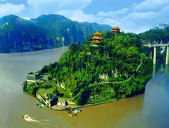 | The longest among the Yangtze Gorges, Xiling Gorge stretches west to east for 76 kilometers from the mouth of the Xiangxi River at Zigui in Hubei Province to Nanjing Pass near the city of Yichang in Hubei. It is divided into two sections -- the west section consists of the Military Book and Sword Gorge, the Bull's Liver and Horse's Lung Gorge and Kongling Play Gorge, while the east section features the Shadow Play Gorge and the Yellow Cat Gorge, otherwise known as Yichang Gorge. |
Along this gorge sit many archeological sites, including the Huangling Temple, first built during the Three Kingdoms Period (220-280). In addition, the Three Visitors' Cave and the Luyou Fountain all have their unique features.Xiling Gorge is known for dangerous rapids and numerous shoals including the Qingtan, Kongling and Xietan shoals. The shoals were formed out of fallen and rock from banks, boulders and sands washed down from the upper reaches, veins protruding from the riverbanks, or reefs jutting out of the riverbed. At some points there are treacherous whirlpools and the waters are extraordinarily turbulent. Like many rivers, the river is known by different names over its course. At its source, it is called in Chinese the Dangqu (當(dāng)曲, from the Tibetan for "marsh river"). Downstream, it is called the Tuotuo River (沱沱河) and then the Tongtian River (通天河, literally "river passing through heaven"). Where it runs through deep gorges parallel to the Mekong and the Salween before emerging onto the plains of Sichuan, it is known as the Jinsha River (金沙江 Jīnshā Jiāng, literally "golden sands river").
The Yangtze River plays an important role in cultural origins of southern China. Human activity was found in the Three Gorges areas as far back as 27 thousand years ago During the Spring and Autumn Period, Ba and Shu were located along the western part of the river, covering modern Sichuan, Chongqing, and western Hubei. Chu was situated along the central part of river, corresponding to Hubei, Hunan, Jiangxi, and southern Anhui. Wu and Yue were based along the eastern part of the river, where is now in Jiangsu, Zhejiang, and Shanghai. Although the Yellow River region was richer and developed better at that time, mild climate and peaceful environment made the Yangtze River area more suitable for agriculture.
The Yangtze River has become more and more important to the development of China’s economy since the Han Dynasty. The establishment of irrigation systems made agriculture very stable and productive. The most famous one was Dujiangyan, northwest of Chengdu established during the Warring States period. By the Song dynasty, the area along the Yangtze had become among the most wealthiest and developed parts of the country, especially in the lower reaches of the river. Early in the Qing dynasty, the region called Jiangnan (that includes the southern part of Jiangsu, the northern part of Zhejiang, and the southeastern part of Anhui) provided 1/3-1/2 of the nation's revenues. The Yangtze has long been the backbone of China's inland water transportation system, which remained particularly important for almost two thousand years, until the construction of the national railway network during the 20th century. The Grand Canal connects the lower Yangtze with the major cities of the Jiangnan region south of the river (Wuxi, Suzhou,hangzhou) and with northern China (all the way to Beijing). The less well known ancient Lingqu Canal, connecting the upper Xiang River with the headwaters of the Guijiang, allowed a direct water connection from the Yangtze Basin to the Pearl River Delta. |